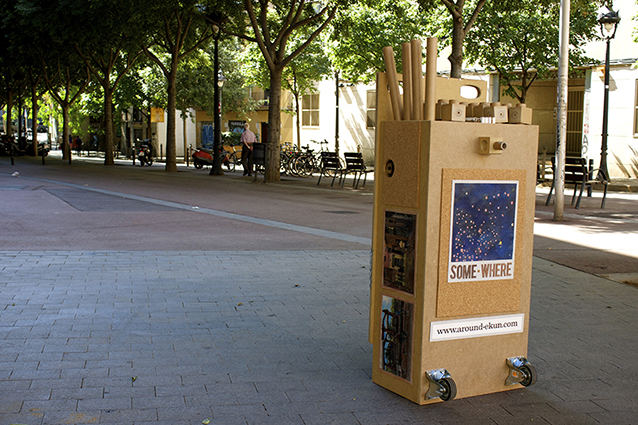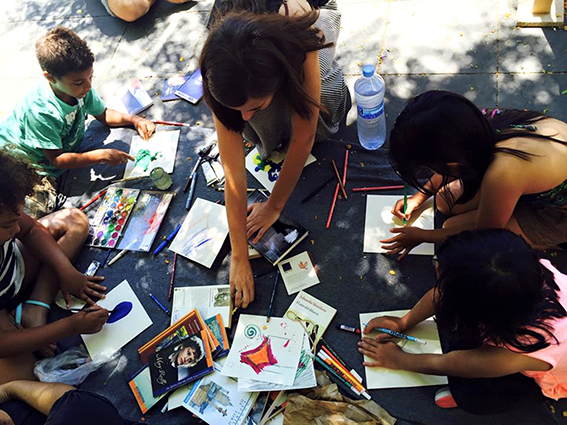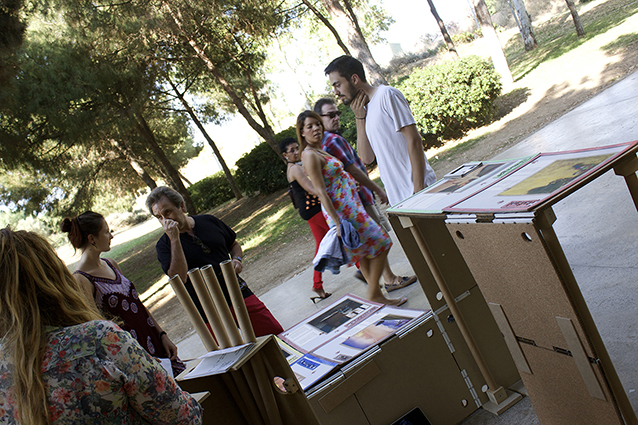Some.where
Abstract
Some.where aims to develop communication means between people in the street and provide meeting places where people are enriched of the exchange of personal experiences. The project Some.where uses tools of Social and urban Design to explore in the field of human relations, underlining the value of the urban environment and the contribution of people who are socially excluded.
(Direct Link: www.around-ekun.com/#!somewhere/c1rqi)
Explanation
This project provides a social and urban analysis by means of ephemeral interventions in public spaces. Each intervention deals with global community topics, stories of people of specific environments, and the inner-self. The physical and graphical support of the intervention is implemented through a single, foldable, and portable device that fits to each environment. Depending on the way that the devise is installed, different visual messages are deployed. Once the intervention is completed, the device is folded and the interaction between people fades.
The Some.where project started in 2015, in the city of Barcelona, focusing on people living on the street. Since its inception, one of the main concerns of this social design project was referred to the way that our attention, our behaviour and environmental appreciation are modified by the mix of design tools and people’s experiences including those socially excluded). The implemented methodology is an interactive and ethnographic social analysis, which uses the technique of the “Participant observation”, interviews, surveys and planned interventions. Research topics are created in an ongoing process of action-research, allowing the experimentation with the people, in such a way that people’s reactions may feed a new intervention.
Finally, the Some.where project intends to imply that the action of an ephemeral intervention in the street may be the preface to a longer lasting action, this time, in the inner privacy of people who observe or participate. This project may introduce people to an exercise of personal and emotional development, and (ultimately) to a transformation of the reality and to social changes.












Thank you Thomas for sharing this project. I find it inspiring to see how you explore ways of making evident the -mostly invisible- conflicts of public space in contemporary cities. Fruitful dialogue and meaningful PHYSICAL interactions help feed this so needed conversation.
I am particularly interested in this aspect: “Some.where project intends to imply that the action of an ephemeral intervention in the street may be the preface to a longer lasting action”. It is of great importance to inquire and explore how site and time-specific interventions might have a longer-lasting impact (we speak of ‘infrastructuring’, within our group). You mention how, by affecting specific individuals, this will reflect on their own contexts. But do you have any ideas of how this may happen? I mean, can you consider the possibility of the intervention to ‘extend’ (and evolve) to this personal contexts? Which form(s) could this take? How can they foster social (re)organization?
I will try to answer your questions in few points. As you understood, the “artefact” or “device” is a communication tool used to bring people around some different actions, but especially to make them share their personal way to think, feel, observe, care about their environment. We collected all these momentary reactions into physical samples (draws, poems, key words, etc.). A small but powerful feedback…
With Some.where, we worked the social exclusion of people living in the streets of Barcelona. This different point of view had to make us think (us, people who do not live in the street) about what we really value, and if sometimes we ponder about it (as the value of a book, a roof, a family, our rights and freedoms in public spaces, etc.).
As we can work with people living in the streets (to don’t call them “homeless”… but this is for an other debate), we can create more artefacts in other contexts (countries, cities, neighborhoods, etc.), to create and include conversations around other topics connected to excluded communities…, finally presenting a way to design empathy. Empathy for understand ourselves (socio-cultural background, personal opinions, behavior, feelings, etc.) before to understand the others. I believe that the change starts when we see, feel and understand our personal environment in a different way than we used to do, even if it’s just for a moment…, and then, we come back in… to our inner reality. Maybe there has never been any change. Or maybe we can see a thought or a conversation as a little evolution to fortify the human being’s community. But from my point of view, you are talking about a longest project: How to continue this feedback chain? Do we need to continue it? Now we have the first physical feedbacks, do we need a longest one, quasi infinite? In any case, your curiosity revealed my hypothesis to all my researches: How do we communicate with our emotions?
You asked: which form could this take? In this case I continued with a human data map as a possible continuation of Some.where. I recommend you to see the design-ethnographic workshop that I did at the design museum of Barcelona (FAD) with 37 youngsters who came from different countries of Europe. Maybe you will find a connection: http://www.around-ekun.com/#!blank/wdxjo. Step-by-step, it allows me to continue developing a methodology.
Thank you for your comprehensive response Thomas! Your approach brings to my mind many different thoughts and ideas.
On one side, it reminds me of Manfred Max-Neef who, after working for some years with the Shell and development agencies, realizes that economy has nothing to do with stock exchange indexes and macro numbers, but about how people experience it in their daily lives: http://www.lamarea.com/2014/07/06/manfred-max-neef-el-rescate-de-los-delincuentes-financieros-es-la-mayor-inmoralidad-de-la-historia-de-la-humanidad/ Have you had a similar realization about design? An interesting thing to reflect on…
In this same order of ideas, I like how, in this project [and in your practice as a whole] design is presented as essentially ‘human’ (thinking of Vilem Flusser’s “Philosophy of Design”). In that case, the ultimate design will be to design ourselves. It might be of your interest the next edition of the Istanbul Design Biennial: http://tasarimbienali.iksv.org/en/archive/newsarchive/p/1/1229
At last, it brings to my mind the lecture that Carl DiSalvo gave at our last Autumn School, where he spoke about the ‘social turn’ in design (as I had described it before, making reference to Klaus Krippendorf’s “Semantic Turn”). Perhaps this is even going beyond, towards a “Human turn”?
Perhaps too many reflections and no concrete questions, but I guess that’s a good thing!
I really like the expression or concept about to “design yourself”. I can understand it as a human purpose, but it’s also considering the fact that a block of wood, designed with its shape, it’s also part of the experience of designing yourself. We use to think that a block of wood is just a form. But behind the shape there is life, an experience of life. So, what is hidden behind people’s body and behind a block of wood?
I used to call my device “artefacta”. Yes she’s alive. She has a strong personality, forms, she’s full of surprises… Depending of her mood she will interact in one place or another, sometimes she is carried away by others persons than me … At the beginning she was my little baby going outdoor for the first time, and then she lived her experiences… She has acquired knowledge, little pain, little joys, etc. Yes, I already put my emotions in this “block of wood”, that cannot be considered as a single design…there is something more hidden some.where behind the appearances…
Dear Thomas. Your project and our discussion has sparked many interesting ideas some.where else.where. In Jeannette Petrik’s contribution (A Parasitical Breed of Consumers), the idea of ‘designing yourself’ came about in a different form: http://www.traderstalk.org/contribution/a-parasitical-breed-of-consumer-3/
Then, in a Facebook post by my friend César Reyes Nájera (of dpr-barcelona) in which he shared an article by Boris Groys (The Obligation to Self-Design), the discussion and your project became relevant all over again: http://www.readingdesign.org/obligation-to-self-design
In the article, Groys says: “The ultimate form of design is, however, the design of the subject”. Have a read through the essay, it might be of your interest and enrich your practice and vision: http://www.readingdesign.org/obligation-to-self-design